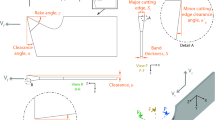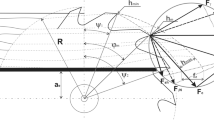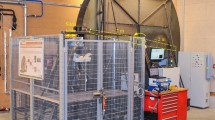Abstract
Cutting forces in bandsaw processing of oak and beech wood were measured at two levels of wood moisture content (about 12 % and FSP) for four cutting directions (90°–90°, 90°–0°, 0°–90° and 90°–45°). A constant cutting speed of 40 m/s and a feed rate of 20 m/min were applied. A piezoelectric dynamometer (KISTLER type 9257A) mounted on the carriage of the vertical bandsaw machine (ESTERER model EB 1400) was used to measure the parallel, normal and lateral cutting forces. Results revealed that all cutting forces depend on the wood moisture content and cutting direction. The greatest parallel force was observed for oak wood at 12 % MC for 90°–90° cutting direction (44 N/mm) whereas the lowest one was for beech wood at 30 % MC for 0°–90° cutting direction (20 N/mm). In contrast to the little change of lateral force at various cutting directions, the change in parallel force was significant.
Zusammenfassung
Gemessen wurden die Schnittkräfte beim Bandsägen von Eichen- und Buchenholz bei zwei verschiedenen Holzfeuchten (12 % und Fasersättigung) und vier Schnittrichtungen (90°–90°, 90°–0°, 0°–90° und 90°–45°) bei einer konstanten Schnittgeschwindigkeit von 40 m/s und einer Vorschubgeschwindigkeit von 20 m/min. Zur Messung der drei verschiedenen Schnittkräfte (parallel und rechtwinklig zur Holzoberfläche und in Querrichtung) wurde ein Piezo-Dynamometer (KISTLER Typ 9257A) verwendet, der auf dem Vorschubwagen mit einer vertikalen Bandsäge (ESTERER Modell EB 1400) montiert war. Die Ergebnisse zeigten, dass alle Schnittkräfte von der Holzfeuchte und der Schnittrichtung abhängen. Die Schnittkraft parallel zur Holzoberfläche war bei Eichenholz mit 44 N/mm bei einer Holzfeuchte von 12 % und einer Schnittrichtung von 90°–90° am größten und bei Buchenholz bei 30 % Holzfeuchte und einer Schnittrichtung von 0°–90° mit 20 N/mm am geringsten. Im Gegensatz zu den signifikanten Unterschieden bei der Schnittkraft parallel zur Holzoberfläche waren die Unterschiede bei der Schnittkraft in Querrichtung gering.








Similar content being viewed by others
References
Cooz V, Mayer RW (2006) Cutting forces for tension and normal wood of maple. For Prod J 56(4):26–34
Costeset JP, Lim Ko P, Ji T, Decés-Petit C, Altintas Y (2002) Orthogonal cutting mechanics of maple: modelling a solid wood-cutting process. J Wood Sci 50:28–34
Cristóvão L, Broman O, Grönlund A, Ekevad M, Sitoe R (2012) Main cutting force models for two species of tropical wood. Wood Mat Sci Eng 7:143–149
Dalois C (1990) Manuel de sciage et d′affutage. Centre Technique Forestier Tropical, Department du CIRAD
Ekevad M, Cristovao L, Marklund B (2012) Lateral cutting forces for different tooth geometries and cutting directions. Wood Mater Sci Eng 7:126–133
Eyma F, Méausoone PJ (2001) Influence of the transitional zone of wood species on cutting forces in the router cutting process (90°–0°). Holz Roh-Werkst 59:489–490
Eyma F, Méausoone PJ, Martin P (2004) Study of the properties of thirteen tropical wood species to improve the prediction of cutting forces in mode B. Ann For Sci 61:55–64
Franz NC (1958) An analysis of the wood cutting process, PhD Thesis. University Michigan, Ann Arbor
Goncalves R, Neri AC (2005) Orthogonal cutting forces in juvenile and mature Pinus taeda wood. Sci Agric 62(4):310–318
Kivimaa E (1950) Cutting force in wood working. State Institute for Technical Research, Helsinki
Koch P (1964) Wood machining process. Ronald Press, New York
Kollmann FFP, Côté WA (1984) Principles of Wood Science and Technology, vol 1, Solid Wood. Springer, New York
Loehnertz SP, Cooz IV (1998) Saw tooth forces in cutting tropical hardwoods native to South America. Research Paper FPL-RP-567
Lučić RB, Goglia V, Pervan S, Dukić I, Risović S (2004) The influence of wood moisture content on the process of circular rip sawing. Part I: power requirements and specific cutting forces. Wood Res 49:41–49
McKenzie WM (1961) Fundamental analysis of the wood cutting process, PhD Thesis. University Michigan, Ann Arbor
McKenzie WM, Ko P, Cvitkovic R, Ringler M (1999) Towards a model predicting cutting forces and surface quality in routing layered boards. In: Proceedings of the 14th IWMS, pp 489–497
Naylor A, Hackney P, Perera N, Clahr E (2012) A predictive model for the cutting force in wood machining developed using mechanical properties. BioResources 7:2883–2894
Ratnasingam J (2002) Wood machining processes: a managerial perspective. Faculty of forestry, Universiti Putra Malaysia
Scholz F, Duss M, Hasslinger R, Ratnasingam J (2009) Integrated model for prediction of cutting forces. In: Proceedings of the 19th IWMS, pp 21–23
Stewart HA (1971) Chip formation when orthogonally cutting wood against the grain. Wood Sci Technol 3(4):193–203
Stewart HA (1979) Analysis of orthogonal wood cutting across the grain. Wood Sci 12(1):38–45
Stewart HA (1991) A comparison of tool materials, coatings, and treatments related to tool wear during wood machining. For Prod J 41(9):61–64
Acknowledgments
This research was carried out at the University of Applied Sciences Rosenheim in Germany. Special thanks to the technicians for their help in the achievement of this work.
Author information
Authors and Affiliations
Corresponding author
Rights and permissions
About this article
Cite this article
Moradpour, P., Doosthoseini, K., Scholz, F. et al. Cutting forces in bandsaw processing of oak and beech wood as affected by wood moisture content and cutting directions. Eur. J. Wood Prod. 71, 747–754 (2013). https://doi.org/10.1007/s00107-013-0734-z
Received:
Published:
Issue Date:
DOI: https://doi.org/10.1007/s00107-013-0734-z




